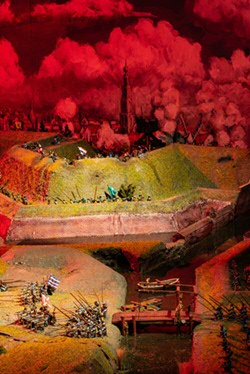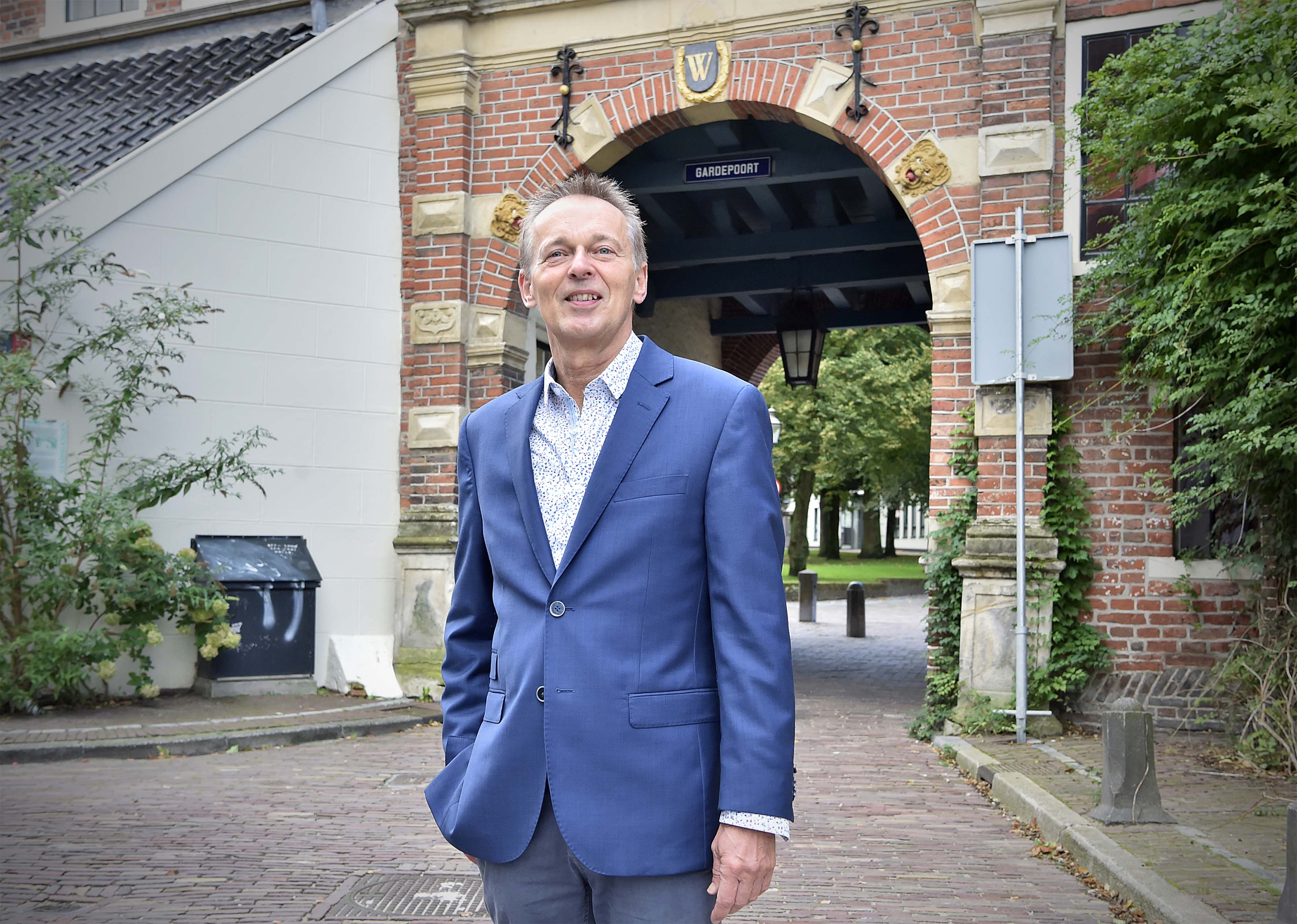A mitred prelate riding a sow

Historian Joop Koopmans studies the role and influence of media in the early modern period. For example, how did newspapers, cartoons, and pamphlets in the ‘Disaster Year’ of 1672 report on ‘Bommen Berend’? To mark the occasion of the 350th anniversary of the Siege of Groningen and subsequent relief (Groningens Ontzet), Koopmans will hold a public lecture on this topic during the Alumni Day.
Text: Mathijs Deen / Photos Koopmans: Elmer Spaargaren
‘Before we continue’, says Dr Joop Koopmans, as he gets up from behind his desk, ‘I will let you have a smell of the “Disaster Year”.’ He pushes a stack of papers aside and produces a package that reminds me of a little organza bag filled with sugared almonds.
Koopmans chuckles as I become a bit frightened. While the ‘Disaster Year’ of 1672 happened 350 years ago, the horror stories about everything that occurred have not lost any of their strength. Why is Koopmans grinning? What is in the bag? Is it the scent of a horse cadaver that was left behind on the battlefield? Some remains of the mutilated body of the Dutch statesman Johan de Witt? A whiff of a direct hit that one of Bommen Berend’s cannons took on a latrine? Or, perhaps just as bad, the odour of a tight mob of unwashed, scared, hungry, and exhausted people in a panicked flight from the enemy?
But no, I was worried for nothing. The little balls that Joop Koopmans holds up to my nose smell of a match being struck (gunsmoke) and orange blossom (embalming fluid).
Hordes of terrified refugees
The fact that I braced myself is related to the power of imagination, which mobilizes fear. The panic that swept the country in 1672 also preceded the arrival of the enemy. Newspapers, pamphlets, cartoons, songs, and whispered rumours informed the people of the mayhem that was being caused by the armies advancing from France, Münster, and Cologne, including arson, murder, and rape.
Needless to say, not all of these rumours were entirely unfounded – the French did indeed cross the river Rhine, one city after another nervously surrendered, and the only way to halt the French offensive was by flooding large parts of Holland and Brabant. And during all that time, the roads were packed with hordes of terrified refugees on their way to the cities of Holland, where they were hoping to find a safe haven. In The Hague, the De Witt brothers were accused of having betrayed the country and were slaughtered like pigs by the mobs.

Second Münster War
This is the dominant history of the ‘Disaster Year’, the Guerre d’Hollande, told from the perspective of Holland. However, the North has its own variant, in which the conflict is referred to as the Second Münster War rather than the Dutch War, and which does not star Louis XIV as the invader, but Bernhard van Galen, the Bishop of Münster.
Van Galen was both a bishop and a monarch, a dual position that gave him the authority to give communion as well as shoot cannons. He was given free reign by Louis XIV to occupy regions and towns east of the river IJssel to which he felt he had historical entitlement as Prince-Bishop of Münster.
Gruesome reports
Here, too, his advance was preceded by gruesome reports that were difficult to verify, Koopmans explains. Here, too, scared citizens fled ahead of the troops to the temporary safety of the Northern cities, and land was flooded to halt the enemy. And here, too, the commander did not succeed in capturing the big city and eventually had to fall back.
On this year’s anniversary of the Siege of Groningen, Joop Koopmans, who studies the role and influence of media in the early modern period, will hold a lecture on how newspapers, cartoons, and pamphlets in the ‘Disaster Year’ reported on Bernhard van Galen. Although at the time of my interview with him, his research on the pamphlets and songs had not quite taken off, he had already studied the cartoons and the two newspapers from that year, the Amsterdamse Courant and the Opregte Haerlemsche Courant. What is noticeable in the cartoons is that Van Galen is often portrayed as a mitred prelate riding a sow, sometimes backwards, with a small army of pigs and piglets following him. In other images, he rides a beguine or a wolf. These rather gloomy images aimed to warn their audience that the bishop’s moral standards were of dubious quality and that unrest was nigh.
Hungry for news
Koopmans is positive about the newspaper reports in 1672. ‘You can see that the editors were really doing their best to report objectively about the troops that were moving up past Coevorden and Bourtange,’ he says, ‘But this was very difficult to do. Disclaimers were constantly added, such as “we have heard that… a traveller from Harlingen told us that… but this has not yet been confirmed.”’
The anxious nation was hungry for news. ‘There was a lot of uncertainty and news reports came in slowly’, Koopmans continues. ‘The Siege started on 21 July, but this news did not make it to the Opregte Haerlemsche until the 28th.’ 'Den Bisschop van Munster is hier aen de zuydtzyde van de Stadt genadert met een Treyn van ongevaer 20000 Man, soo men gist…' [‘The Bishop of Münster has approached the south side of the city with an army of about 20,000, according to estimates...’].
And despite all efforts to print nothing but the truth, incorrect rumours did also reach the pages of the Opregte. For example, on 16 August, the paper had this to say about the bishop, who was very much alive: '… hier is een Vriesse Schipper (...) dese rapporteert, hoe dat binnen Groeningen een Overloper uyt het Bisschopse Leger was gekomen, seggende, dat den Bisschop van Munster, door een schoot uyt de Stadt gequetst zijnde, aen zijn Quetsuur was gestorven…' [‘... a Frisian sailor reported how a defector from the Bishop’s army had come to Groningen and said that the Bishop of Münster had died of a wound from a gunshot that came from the city...’].

Ukraine
When asked about how he looks back on how the advance, the siege, the bombing, and the relief were reported on, Koopmans briefly falls silent, and then says: ‘I am amazed how similar the reporting of those days is to how Ukraine is covered in the media today. I am reading about sieges, people on the run, villages that are being burnt down, women who are being raped, random murders... today’s weapons are different from what was used back then, but the patterns are very similar.’ He glances outside and continues: ‘And so is the insecurity about what the invading army will do. Remember when that convoy was on its way to Kyiv and it became cloudy so the satellites couldn’t see anything? We knew that a large force was heading towards the city, but we had no idea how it was advancing. There was nothing but fear. It was no different in 1672.’
Joop W. Koopmans (1959) is an associate professor of Early Modern History at the University of Groningen. He publishes on media and politics in the sixteenth to eighteenth centuries. Koopmans’ public lecture is part of a symposium on the Siege of Groningen during the Alumni Day on Saturday 27 August.
This article has been taken from our alumni magazine Broerstraat 5.
More news
-
03 November 2025
Menopause in perspective: How the media influences our perception
-
23 October 2025
Nine UG researchers awarded Vidi grant
-
16 October 2025
Exploratory scenarios for the future of the Harmonie Complex
